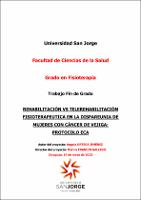Por favor, use este identificador para citar o enlazar este ítem:
https://repositorio.usj.es/handle/123456789/936
| Título : | Rehabilitación vs telerehabilitación fisioterapeutica en la dispareunia de mujeres con cáncer de vejiga: protocolo ECA |
| Autor: | Ortega Jiménez, Ángela |
| Afiliación : | Universidad San Jorge |
| Palabras clave : | Cáncer de vejiga; Dispareunia; Terapia de dilatadores; Biofeedbcak; Suelo pélvico; Mujeres; Función sexual; Fuerza muscular; Bladder cancer; Dyspareunia; Dilators therapy; Biofeedbcak; Pelvic floor; Women; Sexual function; Muscle strength. |
| Fecha de publicación: | 19-may-2023 |
| Editorial : | Universidad San Jorhe |
| Resumen : | Antecedentes: el cáncer de vejiga es el más común del tracto urinario que afecta tanto a hombres como a mujeres. El tratamiento de este genera consecuencias como las disfunciones sexuales, de las cuales, una de las más comunes es la dispereunia. Esta patología tiene un tratamiento multifactorial, donde la fisioterapia juega un papel importante. Hay diversos tratamientos fisioterapéuticos que abordan la dispereunia, pero los más utilizados son la terapia con dilatadores y ejercicios del suelo pélvico mediante biofeedback. Objetivos: relacionar las mejoras del dolor, la función sexual y la fuerza muscular con la telerehabilitación o la rehabilitación presencial, en mujeres con dispereunia supervivientes al cáncer de vejiga a doce semanas de iniciar el tratamiento. Material y Métodos: diseño: protocolo de ensayo clínico aleatorizado. Reclutamiento: durante tres meses en el hospital Miguel Servet y mediante la asociación española Contra el Cáncer (AECC). Emplazamiento: instalaciones de la Universidad San Jorge. Participantes: 36 sujetos que cumplen los criterios de inclusión repartidos en grupo intervención y grupo control. Intervención: doce semanas de telerehabilitación frente a rehabilitación convencional. Seguimiento: a la sexta y doceava semana de empezar la intervención. Variable principal: dolor con EVA (Escala analógica visual) y NRS (11-point Numerical Rating Scale). Cegamiento: de las personas responsables de realizar las mediciones. Resultados esperados: se espera que haya mayor mejora en todas las variables de ambos grupos, siendo más significativa en el grupo intervención que realiza la telehrehabilitación.Conclusión: la telerehabilitación puede llegar a ser una opción más de tratamiento en pacientes con cáncer de vejiga y dispareunia ya que mejora el dolor, la función sexual y la fuerza muscular. |
| Descripción : | Background: bladder cancer is the most common cancer of the urinary tract affecting both men and women. Its treatment generates consequences such as sexual dysfunctions, one of the most common of which is dyspereunia. This pathology has a multifactorial treatment, where physiotherapy plays an important role. There are several physiotherapeutic treatments that address dyspereunia, but the most commonly used are dilator therapy and pelvic floor exercises using biofeedback. Objectives: to relate improvements in pain, sexual function and muscle strength with telerehabilitation or face-to-face rehabilitation in women with dyspereunia surviving bladder cancer 12 weeks after starting treatment. Material and Methods: design: randomized clinical trial protocol. Recruitment: during three months at the Miguel Servet hospital and through the Spanish Association Against Cancer (AECC). Setting: facilities of the San Jorge University. Participants: 36 subjects meeting the inclusion criteria, divided into intervention and control groups. Intervention: twelve weeks of telerehabilitation versus conventional rehabilitation. Follow-up: sixth and twelfth week after starting the intervention. Main variable: pain with VAS (Visual Analog Scale) and NRS (11-point Numerical Rating Scale). Blinding: of the persons responsible for taking the measurements. Expected results: it is expected that there will be greater improvement in all variables in both groups, being more significant in the intervention group that performs telerehabilitation. Conclusion: telerehabilitation can become another treatment option in patients with bladder cancer and dyspareunia as it improves pain, sexual function and muscle strength. |
| URI : | https://repositorio.usj.es/handle/123456789/936 |
| Aparece en las colecciones: | Grado en Fisioterapia |
Ficheros en este ítem:
| Fichero | Descripción | Tamaño | Formato | |
|---|---|---|---|---|
| Rehabilitación vs telerehabilitación.pdf | 3,79 MB | Adobe PDF |  Visualizar/Abrir |
Este ítem está sujeto a una licencia Creative Commons Licencia Creative Commons

